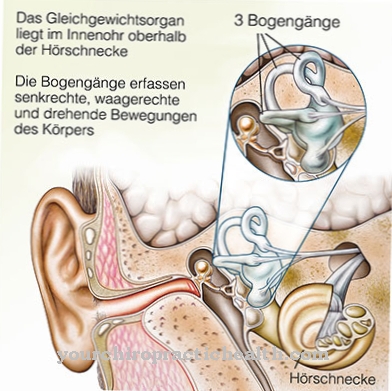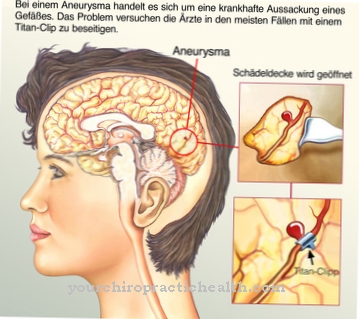The big toe is also known as "hallux". If this begins to deviate, a Hallux varus spoken. Here, a swelling often develops on the inner side of the metatarsophalangeal joint of the big toe, which can be bothersome in normal footwear and also become inflamed.
What is hallux varus?

© designua - stock.adobe.com
Hallux Varus (Splay toe) describes a condition in which the big toe points away from the second toe. The lateral joint capsule is insufficient or absent and the medial capsule is contracted. In contrast to the ball of the foot, the 1st metatarsus remains in the anatomical position. The big toe, on the other hand, deviates towards the middle of the body. This very rare deformity is the opposite of what is known as hallux valgus.
Hallux varus is a very common complication of hallux valgus surgery. Other cases are either congenital or post-traumatic. The symptoms depend on how severe the deformity is. The splayed toe can press against the shoe. The skin in this area is then mechanically irritated, reddened and painful, which can lead to inflammation.
causes
Hallux varus is a very common complication of hallux valgus surgery. If the soft tissue is corrected excessively during the operation or the lateral sesamoid is removed, the risk of hallux varus is increased. The misalignment can show up shortly after the operation or it can only develop over time.
The misalignment is often favored when walking due to stress on the outer edge of the foot. But other causes can also lead to this disease, for example a congenital malformation. This is known as hallux varus congenitus. In some cases, hallux varus is also caused by growth disorders, spastic diseases or complex syndromes.
Occasionally, accidents that lead to injuries, for example getting caught with the big toe, can lead to hallux varus. The misalignment can often be observed in middle-aged people walking barefoot.
Symptoms, ailments & signs
Typical symptoms of hallux varus include tenderness on the big toe, which is caused by the axial deviation. In addition, the forefoot widens in the shoe. Movement-dependent pain often occurs in the metatarsophalangeal joint of the big toe. The pressure in the shoe and the hanging, for example when putting on the stockings, are particularly disturbing for those affected. Occasionally, the misalignment can also lead to an ingrown nail.
Diagnosis & course
Diagnosing it is pretty straightforward because it's easy to see the big toe pointing from the second toe towards the center of your body. During the examination, the medial lateral deviation of the big toe is determined in degrees. In addition, manual redressability and mobility in the metatarsophalangeal joint of the big toe are checked. The forefoot is also x-rayed in two planes in order to assess the condition of the metatarsophalangeal joint, the position of the sesamoid bone and the extent of the big toe deformity.
In many children the deformity regresses by itself in the course of development. In the other cases, the prognosis is usually good. Only in a few cases that remain untreated can hallux varus lead to restricted mobility, pain and even osteoarthritis in the long term. Above a certain degree, this deformity cannot be tolerated functionally or cosmetically and should therefore be corrected as soon as possible. Treatment is advisable if there is pain when walking or if the abdomen is significantly larger.
Complications
Hallux varus usually causes discomfort to the big toe. This mainly results in swelling, which can lead to considerable pain and thus to restrictions in walking and running. This swelling can be very annoying, especially in footwear, and often leads to inflammation.
The pain can spread to the entire foot and thus lead to a misalignment of the foot or the entire leg. Furthermore, osteoarthritis can develop and the quality of life of the person affected is considerably reduced by the hallux varus. It is not uncommon for strenuous movements to be avoided, and it is no longer possible for the patient to perform various types of sport.
The misalignment usually also leads to a cosmetic complaint, so that those affected feel ashamed of this complaint and suffer from a reduced self-esteem.Under certain circumstances, this can also lead to inferiority complexes. There are no further complications with the treatment.
Hallux varus can be treated with suitable footwear. In severe cases or in the case of severe malpositions, a surgical procedure can also be carried out. There is no reduction in life expectancy.
When should you go to the doctor?
If tenderness is noticed on the big toe, hallux varus may be the cause. A doctor should be consulted if the symptoms do not go away on their own or if further symptoms appear. In any case, a doctor should be consulted if there are accompanying symptoms such as an ingrown toenail, pressure points and edema.
Hallux varus must be clarified and treated to avoid further complications. If the misalignment remains untreated, chronic complaints can arise, which are usually a great burden for the person concerned.
Because of this, any unusual symptoms should be observed and medically examined. If the symptoms arise after a hallux valgus operation, the responsible doctor must be informed. Then another intervention is usually necessary to correct the misalignment.
People who have a congenital malformation of the foot or big toe are particularly prone to hallux varus. Patients with stunted growth or spastic diseases are also at risk and should have unusual symptoms examined quickly. In addition to the family doctor, an orthopedic surgeon can also be involved.
Doctors & therapists in your area
Treatment & Therapy
Treatment for the condition depends on the cause. For children with a tight adductor tendon, it is recommended that treatment aims to straighten the tendon, for example by doing stretching exercises or splinting the toes. A misalignment of the big toe below 10 ° usually does not require therapy. Larger misalignments can be compensated for with suitable footwear with a narrow forefoot area if the hallux varus can be redressible.
This means that the big toe can be pushed back into its original position. Conservative therapy includes manual therapy to stretch the medial soft tissues. Acute therapy includes reducing bandages and splints. If the deformity remains unsuccessful with conservative treatment, surgery may be required. The toe is brought into a neutral or straight position. Hallux varus, which is a complication of a hallux valgus operation, often requires additional corrective interventions.
The operative therapeutic measures consist of lengthening the medial capsule parts and ruffling the lateral parts. In rare cases, severe deformities may require arthrodesis of the metatarsophalangeal joint of the big toe. Ultimately, the scope of the operation always depends on the degree of the deformity. The earlier the disease is recognized and treated, the easier it is to carry out corrective interventions. Several months of restraint of the big toe are necessary to ensure the success of the therapy.
Outlook & forecast
The prognosis for hallux varus can be classified as extremely favorable. This is not only due to the fact that the deformity usually resolves itself in children. Surgical treatment also promises lifelong freedom from symptoms. In addition, conservative therapy is sufficient in many cases.
Often there is only a 10 degree deformity. In these cases, doctors do not intervene because there is no real impairment. Treatment would be more of a cosmetic nature. In addition, one does not have to choose the operation automatically. Conservative therapy often leads to success. The therapists' experience of stretching the soft tissues shows good results. In addition, one resorts to traction therapy.
There are hardly any other risks involved in an operation than in other interventions. Infections, bleeding, thrombosis or damage to nerves are conceivable, but represent a general danger. The functional scope of the big toe is extremely rarely reduced. Patients can contribute a lot to a positive outcome after an operation. Recommended footwear is to be worn and training exercises to strengthen the muscles are to be followed. After a good six months, swellings and restricted mobility subside.
Prevent
If hallux varus is hereditary, it usually cannot be prevented. To prevent the disease, avoiding inward rotation of the foot when the baby is lying on their prone can help. If the first signs of hallux varus appear, medical advice should be sought. If necessary, measures against the disease can be taken as early as possible.
Aftercare
Depending on the healing process, the big toe should be stabilized with a bridle bandage for at least four weeks after the operation. This is to prevent the healing bone from loosening again and the toe from returning to the malposition. Restrictions are also advised in the context of conservative therapy.
The bandage not only fixes the big toe in the desired position. With its light compression, it also helps improve venous activity and drain blood and lymph fluid more easily. This minimizes internal pressure on the wound, which counteracts swelling. The first bandage is put on by a specialist. However, after the instruction has been given, the patient can take over the regular changes himself.
A forefoot relief shoe helps to take it easy after the operation and to support the healing process. Nevertheless, it is advisable to roll your foot back over the big toe as soon as possible and to return to a normal gait pattern.
In any case, regular follow-up examinations by the specialist are essential. Swelling and restricted mobility in the basic joint should subside in the first six months after the procedure, but in individual cases they can last significantly longer. However, if neither the surgical nor the conservative therapy is successful, or if the patient continues to struggle with pain and restricted mobility, consideration should be given to immobilization by means of joint stiffening.
You can do that yourself
A splay toe very often develops as a result of hallux valgus surgery. The so-called ball toes, in turn, usually arise as a reaction to permanent incorrect stress on the foot. Instead of the heel, the body weight is directed onto the toes.
The reason for this is very often fashionable but, from an orthopedic point of view, completely nonsensical footwear. The best form of self-help is to wear healthy, well-fitting shoes. Shoes, especially those that are worn regularly and over a longer period of time, should neither have high heels nor point to the front. Shoes with flat, thick soles and a high-quality footbed help prevent misalignments of the feet and toes.
However, a splay toe does not have to be treated in every case. In children, the disorder often resolves on its own as they grow up. From middle age, hallux varus is also very common in people who go barefoot a lot. Those affected usually do not suffer from pain and do not have to take any countermeasures as long as the visual impairment does not irritate them.
In the early stages, the progression of the hallux varus can also be stopped or at least delayed by adjusting behavior. Instead of constantly walking barefoot, those affected should have special orthopedic shoes fitted. Such footwear can help reduce pain when walking or standing, even with more pronounced forms of hallux varus. In this way, an operation can be avoided or at least delayed.
























.jpg)



